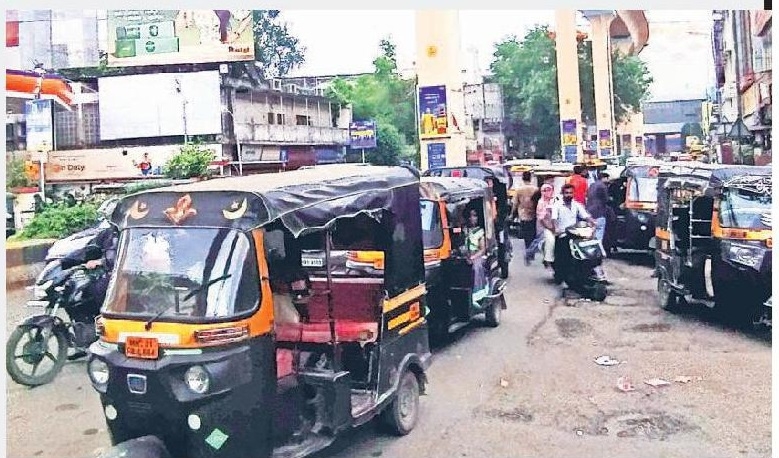Red-flagging Traffic jams Sitabuldi: City’s heart ‘officially’
| Date :16-Jul-2024 |

Staff Reporter :
Considered as the heart of city, Sitabuldi has lost its glory and is slowly descending into chaos, thanks to the city planners’ lack of vision, citizen’s non-adherence to traffic norms, mixed traffic, congested roads, and road-side parking. The stretch from Loha Pul to Jhansi Rani Square and then towards Variety Square to Munje Square, resembles a fish market, during peak traffic movement time, during early morning and in evening hours, with drivers continuously honking, and people yelling at each other due to traffic snarls.
Day after day driving through the stretches on Sitabuldi area is becoming a headache for the Nagpurians. No doubt the number of vehicles plying on road has increased manifold. However, the corresponding and necessary facilities were not created by the planners. Overlooked and neglected for years, the Sitabuldi stretches are turning out to be big gridlock and this happens quite frequently throughout the day.
And if one is travelling in a four-wheeler, then finding even a foot of clear patch without bumping into another vehicle is hard to locate on these road stretches. On top of that, the non-existent footpaths mean the short width of road has to also accommodate the pedestrians and the absence of parking further complicates the scenario.
In short, entire Sitabuldi has been turned into a messy area for the common people.
However, Sitabuldi is one area that is hard to avoid for Nagpurians and invariably one's path gets crossed whenever one has to move towards Civil Lines, the Railway station. This is so as maximum Government offices are confined in one corner and Sitabuldi patch is also key to East-West traffic movement.
So, its inevitable that vehicular pressure is bound to be reflected on the central business area and for the same necessary intervention at planning level was necessary.
To make matter more problematic now the convergence of two routes of
Contd from page 1
Nagpur Metro, the Orange Line and Aqua Line, also takes place at Sitabuldi, Munje Square, it is now a new flash point for traffic congestion. Already, there is criss-cross movement of vehicles and now additional footfall has increased in the area without necessary addition in the infrastructure. So it all boils down to chaotic movement throughout the day with the small patches taking toll of human patience.
The intersection’s inability to handle the massive volume of traffic exacerbates the situation further. There are three major reasons for the traffic congestion in city’s heavily frequented area. The presence of several popular bookstores attracts a large number of visitors adding to the congestion, the vibrant clothing market draws shoppers from all over the city and beyond, increasing both foot and vehicle traffic in the area. Numerous food stalls and restaurants line the streets, attracting mix of job commuters and metro users, further adding to the already crowded area, especially during meal times, in afternoon and evening. The adjoining Dhantoli area serves as extension of Sitabuldi and numerous food joints here bring in additional vehicles to the central part of city and it’s a ready-made recipe for further snarls.
This area has become a focal point for dense traffic congestion due to its strategic location and bustling commercial activities causing significant delays and frustrations among commuters and pedestrians alike. The central location of these squares makes them a magnet for heavy traffics, especially during peak hours from 5 pm onwards and till closure of market.
Jhansi Rani Square serves as a vital junction, connecting the main streets of the city, thus becoming a choking point for vehicles moving in East-West and North-South direction. This rush is primarily driven by commuters leaving the city after work and shoppers who visit the bustling food and clothing market in the area. One of the critical issues contributing to the congestion is the lack of traffic police personnel at Munje Square, below Sitabuldi Interchange Metro Station.
This absence leads to chaos at the intersection, with a mix of commuters and daily metro users converging at the same spot and at the same time, during morning and in evening peak hours.
Another issue is that National Highway No 6 and 7 both converges at Variety Square, so even heavy vehicles, particularly buses of private transporters well as MSRTC ply through Sitabuldi, that causes traffic snarls. In addition, Mor Bhavan is also located in Sitabuldi and this is also terminus for city buses. Even inter-district buses also ply from here and so the entire area is dotted with people right from break of dawn till late evening hours. And as business activity picks up, the crowd starts gathering in numbers and by afternoon, one can witness the crawling of traffic as each category of road users fight for that little space, to manoeuvre and somehow move out unhurt.
Another main cause of traffic congestion is unruly movement of auto-rickshaws.
The wayward parked autos at Munje Square, Jhansi Rani Square and Variety Square, are responsible for adding to already chaotic affair in the heart of city. Further, the footpaths are not accessible as most of them area either occupied by hawkers or by shopkeepers who occupy the same for displaying their wares. These factors create a perfect storm of traffic congestion in the triangle, making it one of the most problematic areas in the city during peak hours.
The congestion not only affects local commuters but also those travelling out of the city via buses and cars. Authorities need to go back to drawing boards and draw-up a master plan to decongest Sitabuldi so that commuters can heave a sigh of relief.
The officials must address
the issues, possibly improving traffic management, enhancing public transportation options and considering pedestrian-friendly infrastructure improvements to alleviate the pressure on these key intersections.